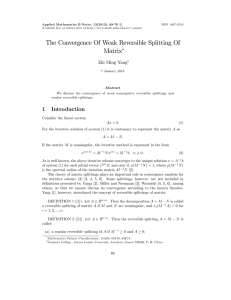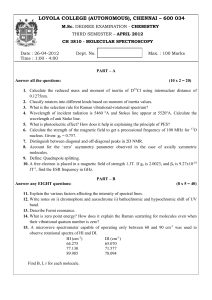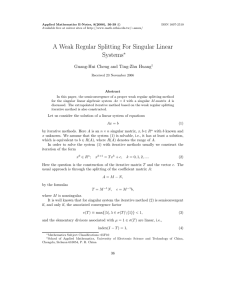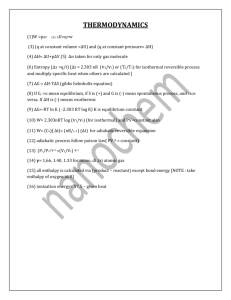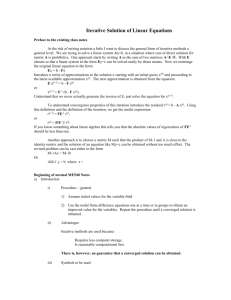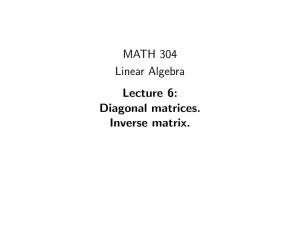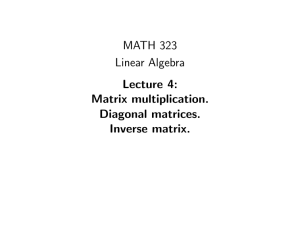Document 10677499
advertisement
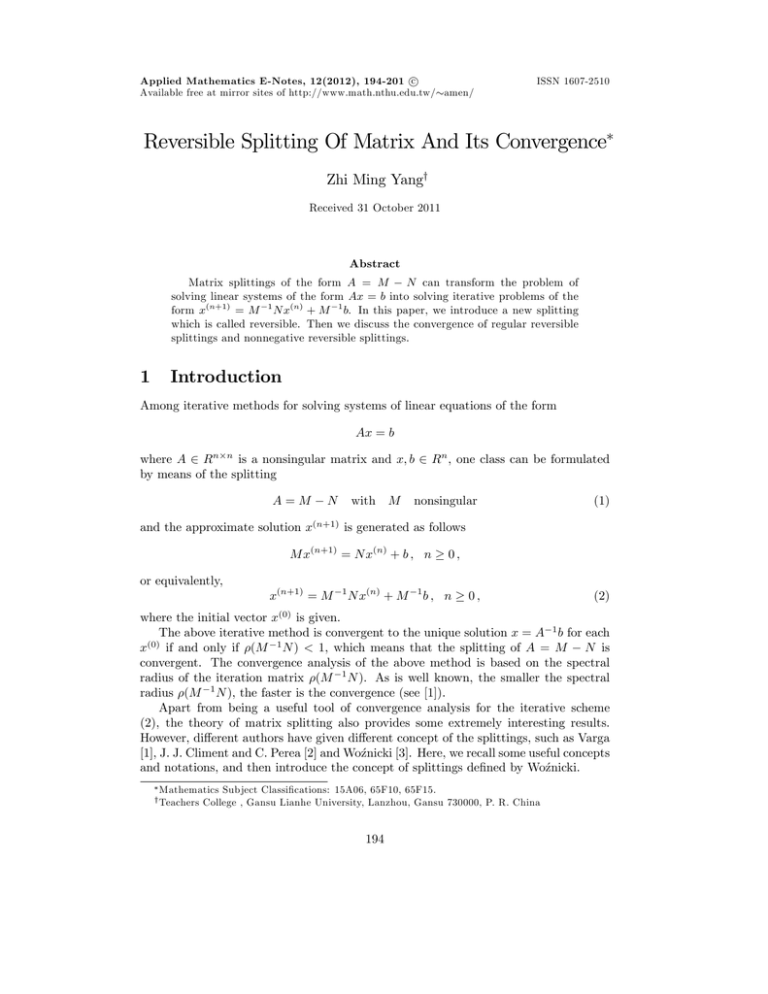
Applied Mathematics E-Notes, 12(2012), 194-201 c Available free at mirror sites of http://www.math.nthu.edu.tw/ amen/ ISSN 1607-2510 Reversible Splitting Of Matrix And Its Convergence Zhi Ming Yangy Received 31 October 2011 Abstract Matrix splittings of the form A = M N can transform the problem of solving linear systems of the form Ax = b into solving iterative problems of the form x(n+1) = M 1 N x(n) + M 1 b. In this paper, we introduce a new splitting which is called reversible. Then we discuss the convergence of regular reversible splittings and nonnegative reversible splittings. 1 Introduction Among iterative methods for solving systems of linear equations of the form Ax = b where A 2 Rn n is a nonsingular matrix and x; b 2 Rn , one class can be formulated by means of the splitting A=M N with M nonsingular (1) and the approximate solution x(n+1) is generated as follows M x(n+1) = N x(n) + b ; n 0; or equivalently, x(n+1) = M 1 N x(n) + M 1 b; n 0; (2) where the initial vector x(0) is given. The above iterative method is convergent to the unique solution x = A 1 b for each x(0) if and only if (M 1 N ) < 1, which means that the splitting of A = M N is convergent. The convergence analysis of the above method is based on the spectral radius of the iteration matrix (M 1 N ). As is well known, the smaller the spectral radius (M 1 N ), the faster is the convergence (see [1]). Apart from being a useful tool of convergence analysis for the iterative scheme (2), the theory of matrix splitting also provides some extremely interesting results. However, di¤erent authors have given di¤erent concept of the splittings, such as Varga [1], J. J. Climent and C. Perea [2] and Woznicki [3]. Here, we recall some useful concepts and notations, and then introduce the concept of splittings de…ned by Woznicki. Mathematics Subject Classi…cations: 15A06, 65F10, 65F15. College , Gansu Lianhe University, Lanzhou, Gansu 730000, P. R. China y Teachers 194 Z. M. Yang 195 DEFINITION 1 ([1]). Let A = (aij ) 2 Rn n ; B = (bij ) 2 Rn n . Then A B (A > B) if aij bij (aij > bij ) for all 1 i; j n. If O is the null matrix and A O, we say that A is a nonnegative matrix. DEFINITION 2 ([1]). Let A be an n n complex matrix with eigenvalues i (i = 1; 2; :::; n). (A) = max1 i n j i j is the spectral radius of A. (A) = min1 i n j i j , and I denotes the identity matrix , i (A) and jAj denote the i-th eigenvalue and the determinant of matrix A respectively. DEFINITION 3 ([3]). Let M; N 2 Rn n : Then the decomposition A = M N is called (a) a regular splitting of A if M 1 0 and N 0; (b) a nonnegative splitting of A if M 1 0 , M 1 N 0 and N M 1 0; (c) a weak nonnegative splitting of A if M 1 0 and either M 1 N 0 (the …rst type) or N M 1 0 (the second type); (d) a weak splitting of A if M is nonsingular, M 1 N 0 and N M 1 0; (e) a weaker splitting of A if M is nonsingular and either M 1 N 0 (the …rst type) or N M 1 0 (the second type); (f) a convergent splitting of A if (M 1 N ) = (N M 1 ) < 1. Di¤erent splittings were extensively analyzed by many authors, see, e.g., [4] and [5]. Some splittings, however, are not included in De…nition 3. For example, let 1 0 4 0 1 A = @ 1 0 2A = M N ; 1 3 3 where 0 12 M =@ 3 3 we can easily see that N M 1 02 3 N = @0 0 36 9 9 2 0 and 2 1 3 0 1 0 0A 6 7 1 0 8 7 14A ; N = @ 2 21 2 0; N M 1 0 B =@ 36 9 15 2 410 189 62 189 13 21 1 6 12A ; 18 632 189 4 189 31 21 1 8 3 2 C 3 A 1 3 0: The above example shows that the splitting is not included in De…nition 3, so that we cannot discuss its convergence according to the theories established by R. S. Varga, Miller and Neumann, Song, among others. The main purpose of this paper is to present a new splitting which is called reversible and discuss its convergence. 2 Reversible Splitting of a Matrix We begin with the following DEFINITION 4. Let A 2 Rn n . Then the decomposition A = M a reversible splitting of matrix A if M; N are nonsingular and i (M i = 1; 2; :::; n. 1 N is called A) > 0 for 196 Reversible Splitting of Matrix and its Convergence DEFINITION 5. Let A 2 Rn n . Then the reversible splitting A = M N is called (a) a regular reversible splitting of A if M 1 0 and A 0; (b) a nonnegative reversible splitting of A if M 1 0 , M 1 A 0 and AM 1 0; (c) a weak nonnegative reversible splitting of A if M 1 0 and either M 1 A 1 0 (the …rst type) or AM 0 (the second type); (d) a weak reversible splitting of A if M 1 A 0 and AM 1 0; (e) a weaker reversible splitting of A if either M 1 A 0 (the …rst type) or AM 1 0 (the second type). 2 1 EXAMPLE 1. Let A = 1 2 6 6 M= =M 6 12 ; Evidently, M; N are nonsingular and ! M 1 = 1 6 1 6 1 3 1 6 > 0; M 1 4 5 N= 1 2 1 6 A= N , where 0 1 6 ! 5 : 10 > 0 ; AM 1 1 2 = 0 1 6 1 6 ! > 0: From i (M 1 A) > 0 (i = 1; 2) we know that the decomposition A = M nonnegative reversible splitting. 1 1 EXAMPLE 2. Let A = = M N , where 1 2 3 3 M= 2 4 ; 2 2 N= 1 : 2 Evidently, M; N are nonsingular and 1 M M 1 2 3 1 2 = A= 1 3 1 2 1 3 0 0 1 2 0; 0; N AM 1 1 1 2 1 1 = = 0: 1 1 6 1 3 1 6 2 3 0: This is a weak nonnegative reversible splitting of the …rst type. 1 2 2 = M N , where EXAMPLE 3. Let A = 1 4 2 3 2 3 2 M= 1 2 ; 1 1 N= 1 : 2 Evidently, M; N are nonsingular and M 1 = 4 3 1 2 3 1 0; N 1 = 2 1 1 1 0: N is a Z. M. Yang 197 M 1 1 3 A= 0 2 0 0; 1 AM 5 3 11 3 4 3 10 3 = 0: It is a weaker reversible splitting of the …rst type. EXAMPLE 4. Consider the splitting given in section 1 where jM j = jN j = 162 6= 0 , and 1 M AM 1 0 B =@ 0 B =@ 221 189 62 189 13 21 2 3 2C 9A 1 0; M 0 632 189 185 189 31 21 so the decomposition A = M 3 1 23 27 22 81 4 63 8 27 10 81 1 63 1 8 3 2C 3A 4 3 0; 01 3 A = @0 0 i (M 1 2 2 3 0 1 0 0A 1701 6= 0, 2 0: 1 7 A) > 0; i = 1; 2; 3; N is a weaker reversible splitting of the …rst type. Convergence of Reversible Splitting In this section, we discuss the convergence of splittings de…ned in the …rst two items of De…nition 5. LEMMA 1 ([1]). If M is an n n matrix with (M ) < 1, then I and (I M ) 1 = I + M + M 2 + ; M is nonsingular where the series on the right converging; conversely, if the series on the right converges, then (M ) < 1. THEOREM 1. Let A = M then (M 1 N ) < 1. N be a reversible splitting of A and (M 1 A) < 1, PROOF. Since A = M N is a reversible splitting, so M is nonsingular and 1 A) > 0; i = 1; 2; :::; n, from N + A = M , we have i (M M 1 N +M 1 A=I and 1 i (M N) + On the other hand, (M 0< From (3) we obtain (M 1 1 i (M 1 A) = 1; i = 1; 2; :::; n: A) < 1 means that i (M 1 A) < 1 ; i = 1; 2; :::; n: N ) = max f i (M 1 i n 1 N )g < 1. (3) 198 1 2 1 6 Reversible Splitting of Matrix and its Convergence EXAMPLE 5. Consider the splitting of matrix A in Example 1, where M ! 0 1 1 , that is, 1 (M 1 A) = ; 2 (M 1 A) = and 1 2 6 6 means that 1 (M 1 N) = 1 ; 2 i (M M 1 2 (M 1 1 1 2 1 6 N= N) = N) + 0 5 6 1 A= ! 5 , that is, 6 i (M 1 A) = 1; i = 1; 2: For the splittings given in Example 2–4, we can also prove that the equality (3) holds, which means that Theorem 1 holds. Now according to Theorem 1, we know that the reversible splitting of A = M N is convergent if (M 1 A) < 1. It is evident, from (3), that the following corollary holds. COROLLARY 1. Let A = M N be a reversible splitting of A and (M 1 A) < 1. Then (M 1 N ) = 1 (M 1 A): 1 For example, in Example 5, we know that (M According to Corollary 1, we obtain (M 1 N) = 1 (M 1 A) = A) = 1 1 < 1 and (M 2 1 5 = : 6 6 1 A) = 1 : 6 (4) But for the splitting given in Example 3, it is obvious that 1 and from M 1 2 3 N= 0 0 1 1 (M 2 1 = ; 3 3 A) = 1 we know that (M (M 1 N ) 6= 1 (M 1 N ) = 1, that is, 1 A): It occurs just because the condition (M 1 A) < 1 does not hold, in fact, (M 1 A) = 2 > 1 in this example. THEOREM 2. Let A = M N be a regular reversible splitting of matrix A: Then the following inequality holds if N 1 0: (M Conversely, if (M 1 1 A) = A) < 1, then N 1 (N 1 A) < 1: 1 + (N 1 A) 0. (5) Z. M. Yang 199 PROOF. From A = M N we have 1 M = N + A = N (I + N A) and M 1 Since M A 1 1 A = (I + N 1 A) 0, there exists a Perron vector x 1 M 1 N A: (6) 0 such that 1 Ax = (M A)x: Now by equality (6), we have (M i.e., (M 1 1 A)x = (I + N A) is an eigenvalue of (I + N 1 (M On the other hand, since N vector y 0, such that A) 1 A) 1 A) 1 1 1 N 1 N Ax; A: Hence (N 1 A) : 1 + (N 1 A) 1 0 and A N 1 1 0, i.e., N Ay = (N 1 (7) A 0, there exists a Perron A)y: On account of (6), we have 1 (M i.e., (N 1 A) 1+ (N 1 A) A)y = is also an eigenvalue of M (M 1 A) (N 1 A) y; 1 + (N 1 A) 1 A, hence (N 1 A) ; 1 + (N 1 A) together with (7) and (N 1 A) > 0, implies (5). Conversely, from A = M N we have N =M If (M 1 A = M (I M 1 A): A) < 1, then from Lemma 1 and De…nition 5, it follows that N 1 = (I M 1 A) 1 M 1 1 X = ( (M 1 A)i )M 1 0: i=0 As an immediate consequence of Theorem 1 and Theorem 2, we obtain the following result. N COROLLARY 2. Let A = M 1 0, then (M 1 N ) < 1. N be a regular reversible splitting of matrix A. If 200 Reversible Splitting of Matrix and its Convergence EXAMPLE 6. Let A = 1 0 M= 2 3 =M 1 4 3 2 0 N , where ; 2 N= 1 0 2 : 1 It is easy to know that the decomposition A = M N is a regular reversible 1 2 1 splitting, and N = > 0 means that the splitting is convergent. In fact, we 0 1 1 have (M 1 N ) = < 1. 2 Similar to the proof of Theorem 2, from N =M A = M (I 1 M A) = (I AM 1 )M ; i.e., N 1 = (I M 1 A) 1 M 1 =M 1 (I AM 1 ) 1 ; we can get the following results. THEOREM 3. If A = M N is a nonnegative reversible splitting of matrix A, then (M 1 A) < 1 if and only if N 1 > 0. COROLLARY 3. Let A = M N be a nonnegative reversible splitting of matrix A. If N 1 > 0, then (M 1 N ) < 1. 2 3 1 3 EXAMPLE 7. Consider the nonnegative splitting given in Example 1, where N ! 1 3 4 15 1 = > 0. By Corollary 3, we know that the splitting is convergent (in fact, we have equality (4)). 4 Remarks As described by Theorem 2 and Theorem 3, the splittings de…ned in the …rst two items of De…nition 5 are convergent if N 1 > 0, but it is not a su¢ cient condition to ensure the convergence of weak and weaker reversible splittings of matrix A, moreover, these two types of reversible splittings can also be convergent even when N 1 0. For instance, in Example 3, though N 1 > 0, the splitting A = M N does not converge because we have (M 1 N ) = 1. But in Example 4, 0 14 1 67 3 9 18 B 10 22 2C N 1 = @ 27 0; 27 3A 1 2 0 54 27 the splitting is convergent because (M 1 N) = 1 (M 1 A) = 1 1 6 = < 1: 7 7 Z. M. Yang 201 Therefore we need to …nd other su¢ cient conditions for a weak (weaker) splitting in the future. Acknowledgment. I would like to thank Professor Sui Sun Cheng for his helpful suggestions to the original manuscript of this paper. References [1] R. S. Varga, Matrix Iterative Analysis, 2nd ed., Springer-Verlag Berlin Heidelberg, 2000. [2] J. J. Climent and C. Perea, Some comparison theorems for weak nonnegative splitting of bounded operators, Linear Algbra Appl., 275-276(1998), 77–106. [3] Z. I. Woznicki, Basic comparison theorems for weak and weaker matrix splittings, The Electronic Journal of Linear Algebra, 8(2001), 53–59. [4] Z. I. Woznicki, On properties of some matrix splittings, The Electronic Journal of Linear Algebra , 8(2001), 47–52. [5] Z. I. Woznicki, Nonnegative splittings theory, Japan J. Industr. Appl. Math., 11(1994), 289–342.
